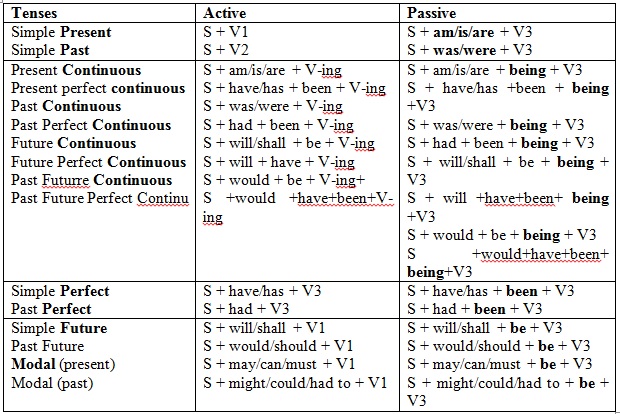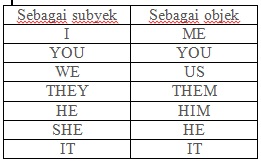NounPhrase
Frasa Benda/Noun Phrase
Suatu frasa benda adalah suatu frasa di mana kata pokoknya adalah kata benda dengan kata-kata lain yang menerangkan kata benda tersebut.
Pembentukan Noun Phrase
Frasa benda bisa di bentuk dengan susunan kata-kata seperti berikut :
1. Article + Noun
a) Indifinite Article + Noun
Noun Phrase dapat terbentuk dengan adanya kata sandang a dan an sebelum kata benda itu.
Contoh : a girl an apple a university
Rangkaian kata a girl adalah suatu frasa kata benda, a menerangkan kata benda girl ; girl adalah kata pokoknya (headword) dalam frasa tersebut, a adalah kata yang menerangkan kata girl.
b) Difinite Article + Noun
Yang dimaksud dengan Definite article adalah kata sandang The.
Contoh : the house the book the boys the pens
Rangkaian kata kata dia atas adalah frasa benda. The menarangkan kata benda house, book, boys, dan pens . Kata-kata house, book, boys, pens adalah kata-kata pokoknya dan “the” menerangkan kata-kata pokok tersebut.
Rangkaian kata kata dia atas adalah frasa benda. The menarangkan kata benda house, book, boys, dan pens . Kata-kata house, book, boys, pens adalah kata-kata pokoknya dan “the” menerangkan kata-kata pokok tersebut.
2. Demonstrative Adjective + Noun
Kata demonstrative adjective antara lain kata this, these, that, dan those.
Contoh : This song That poem those disasters
That stranger These tragedies this liquid
That stranger These tragedies this liquid
3. Possessesive Adjective + Noun dan Possessive noun + noun
Yang dimaksud dengan possessive adjective adalah kata-kata yang menyatakan pemilik sesuatu,
misalnya my, your, his, her, its, our, their, jean’s, Mr.Jones’, dsb.
Contoh : Her computers your ideas Toni’s pen
Contoh : Her computers your ideas Toni’s pen
4. Numerals (kata bilangan)
Yang dimaksud dengan numerals adalah one, two, three, ten, dst.
Contoh :
Two women (=dua orang wanita)
Four members (=empat orang anggota)
Three books (=tiga buku)
5. Quantifier + noun
Adalah kata yang menyatakan banyaknya suatu benda, misalnya some, any, much, many, a lot of, few, a little, dsb.
Contoh : some brothers much money many pencils
6. Adjective + Noun
Adjective (=Kata sifat) adalah kata yang menjelaskan benda dengan kata lain menerangkan sifat benda tersebut. Contoh kata sifat; big (besar), tall (tinggi), old (tua), far (jauh), angry (marah), sad (sedih), dll.
big houses tall men clever students
kata "big" adalah kata sifat yang menjelas kan kata benda "houses"
Cara-cara lain pembentukan noun phrase antara lain:
Article + adjective + noun (contoh; a tall man, the angry bird, dll)
Pada contoh " a tall man",kata "a" adalah article/kata sandang, kata "tall" adalah adjective,
Pada contoh " a tall man",kata "a" adalah article/kata sandang, kata "tall" adalah adjective,
semua kata-kata ini menjelaskan "man".
Article + Adverb + adjective + noun (contoh; a really nice vacation)
Pada noun phrase " a really nice vacation ", kata "a" adalah article, "really" adalah kata keterangan, "nice" adalaj adjective, semua kata ini mejelaskan kata benda "vacation"
Quantifier + adjective + noun
Contoh:
some pretty girls a few new pens
some pretty girls a few new pens
kata "some" adalah quantifier, "pretty" adalah kata sifat, semua kata tersebut menjelaskan kata benda "girls"
Urutan penulisan Noun Phrase dalam Bahasa Inggris mengikuti aturan seperti berikut:
- Determiner, isinya a/an (sebuah) atau the
- Opinion, opini orang ttg benda utama. (mis. handsome, beautiful, cute, dll)
- Size, ukuran (mis. Small, large, big, huge, dll)
- Age, umur/jaman, pokonya yang berhubungan dengan waktu (mis. old, modern, dll)
- Temperature
- Shape, bentuk/penampakan, dll
- Colour
- Original, maksudnya adalah asal benda utama (berasal). Terdiri dari dua;
· Country / City, asal tempat (negara/kota)
· Material, asal bahan (besi, emas, kain, dll)
9. Purpose, berhubungan dengan tujuan dari benda utama.
10. Noun, kata benda utama.
Sekarang sebuah contoh noun phrase lengkap sesuai dengan 10 urutan di atas:
bendanya adalah Car atau mobil
bendanya adalah Car atau mobil
A cute small modern cool round red Germany metallic racing car
A=1, cute=2, small=3, modern=4, cool=5, round=6, red=7, Germany=8a, metallic=8b, racing=9, car=10.
Contoh lain yang lebih pendek:
- Alex is a smart tall white boy (a=1, smart=2, tall=3, white=7, boy=10)
- It's a beautiful red car (a=1, beautiful=2, red=7, car=10)
- Mr. Aldy has just bought an expensive large house (an=1, expensive=2, large=3, house=10)
Dalam menyusun sebuah Noun Phrase yang terdiri dari beberapa Adjectives, maka kita harus menyusun mengikuti urutan yang diberi nama :
OPSHACOM, kata itu kalau dipecah menjadi:
OP (Opinion, mis; beautiful, bad, cute, prety, cheap, etc.)
SH (Shape, mis; big, small, tall, short, long, etc.)
A (Age, mis; new, young, old, etc.)
C (Color, mis; black, red, yellow, blue, etc.)
O (Original, mis; American, Indonesian, Chiness, Russian, Baliness, etc.)
M (Materials, mis; leather, plastics, wood, etc.).
Tambahan lagi, kalau dalam kalimat tersebut harus mencatumkan kata ganti yang juga berfungsi sebagai kata sifat yang menyatakan milik seperti (my, your, his, her, our, their), maka kata ganti ini diletakkan paling awal dalam urutan Noun Phrase tersebut.
Contoh :
1. I have a beautiful short new red plastic ruler, and I put it in bag.
2. She likes eating cheap hot Balinese food for her dinner.
The Noun Phrase
Recognize a noun phrase when you see one.
You can find the noun dog in a sentence, for example, but you don't know which canine the writer means until you consider the entire noun phrase: that dog, Aunt Audrey's dog, the dog on the sofa, the neighbor's dog that chases our cat, the dog digging in the new flower bed.
Modifiers can come before or after the noun. Ones that come before might include articles, possessive nouns, possessive pronouns,adjectives, and/or participles.
Articles: a dog, the dog
Possessive nouns: Aunt Audrey's dog, the neighbor's dog, the police officer's dog
Possessive pronouns: our dog, her dog, their dog
Adjectives: that dog, the big dog, the spotted dog
Participles: the drooling dog, the barking dog, the well trained dog
Modifiers that come after the noun might include prepositional phrases, adjective clauses, participle phrases, and/orinfinitives.
Prepositional phrases: a dog on the loose, the dog in the front seat, the dog behind the fence
Adjective clauses: the dog that chases cats, the dog that looks lost, the dog that won the championship
Participle phrases: the dog whining for a treat, the dog clipped at the grooming salon, the dog walked daily
Infinitives: the dog to catch, the dog to train, the dog to adopt
Less frequently, a noun phrase will have a pronoun as its base—a word like we, everybody, etc.—and the modifiers which distinguish it. Read these examples:
We who were green with envy
We = subject pronoun; who were green with envy = modifier.
Someone intelligent
Someone = indefinite pronoun; intelligent = modifier.
No one important
No one = indefinite pronoun; important = modifier.
Adjectives with Countable and Uncountable Nouns
The Basic Rules: Count and Noncount Nouns
A count noun is one that can be expressed in plural form, usually with an "s." For example, "cat—cats," "season—seasons," "student—students."
A noncount noun is one that usually cannot be expressed in a plural form. For example, "milk," "water," "air," "money," "food." Usually, you can't say, "He had many moneys."
Count and Noncount Nouns with Adjectives
Most of the time, this doesn't matter with adjectives. For example, you can say, "The cat was gray" or "The air was gray." However, the difference between a countable and uncountable noun does matter with certain adjectives, such as "some/any," "much/many," and "little/few."
Some/Any: Some and any countable and uncountable nouns.
- "There is some water on the floor."
- "There are some students here."
- "Do you have any food?"
- "Do you have any apples?"
Much/Many: Much modifies only uncountable nouns. Many modifies only countable nouns.
- "We don't have much time to get this done."
- "Many Americans travel to Europe."
Little/Few: Little modifies only uncountable nouns.
- "He had little food in the house."
- "The doctor had little time to think in the emergency room."
Few modifies only countable nouns.
- "There are few doctors in town."
- "Few students like exams."
Other basic rules
A lot of/lots of: A lot of/lots of are informal substitutes for much and many. They are used with uncountable nouns when they meanmuch and with countable nouns when they mean many.
- "They have lots of (much) money in the bank."
- "A lot of (many) Americans travel to Europe."
- "We got lots of (many) mosquitoes last summer."
- "We got lots of (much) rain last summer."
A little bit of:A little bit of is informal and always precedes an uncountable noun.
- "There is a little bit of pepper in the soup."
- "There is a little bit of snow on the ground."
Enough: Enough modifies both countable and uncountable nouns.
- "There is enough money to buy a car."
- "I have enough books to read."
Plenty of: Plenty of modifies both countable and uncountable nouns.
- "They have plenty of money in the bank."
- "There are plenty of millionaires in Switzerland."
No: No modifies both countable and uncountable nouns.
- "There is no time to finish now."
- "There are no squirrels in the park."
Using A and An
There is sometimes confusion about whether to use an or a (particularly with abbreviations). The sound of a word's first letter determines which to use. If the word starts with a vowel sound, you should use an. If it starts with a consonantsound, you should use a.
Examples:
one attracts a and the other an.)
(LRS - Linear Recursive Sequence)
(TT - Tourist Trophy)
('honour' - starts with an o sound)
('US' - starts with a y sound)
('RTA' - Road Traffic Accident)
sumber :


